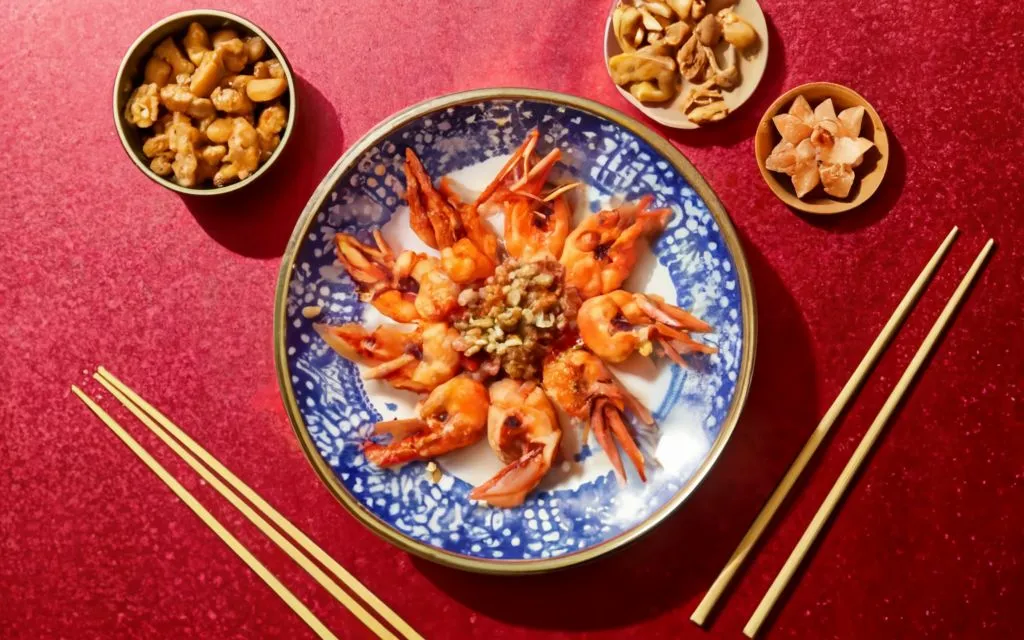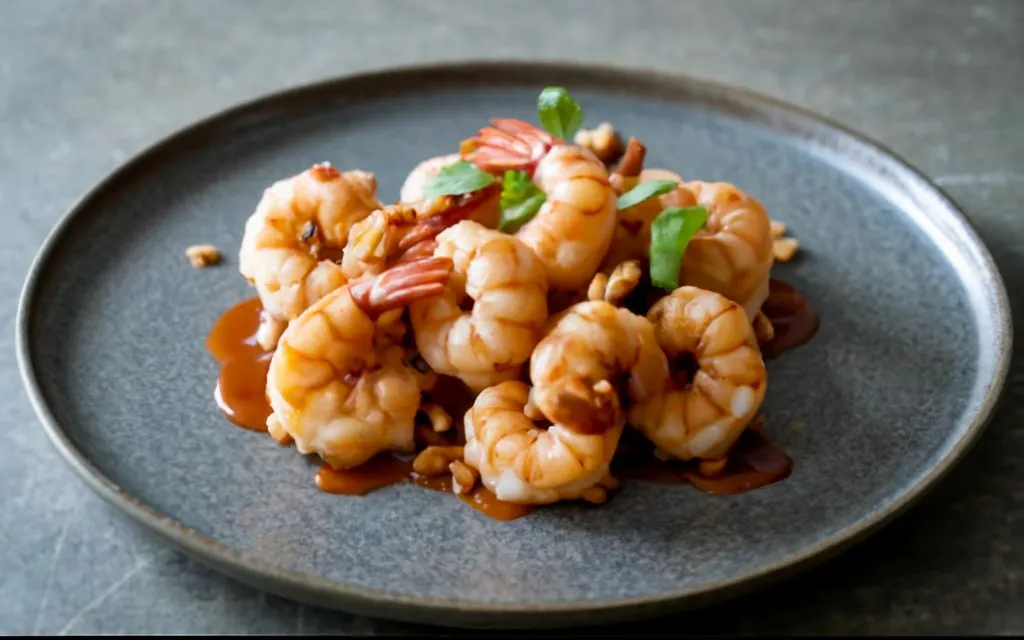In the world of culinary delights, few dishes blend the sweet, the savory, and the crunchy quite like Honey Walnut Shrimp. This Chinese banquet classic has danced its way into the hearts of food enthusiasts worldwide, offering a unique taste that marries the ocean’s bounty with the earthy sweetness of candied nuts. But what lies beneath this beloved dish’s crispy exterior and glossy sauce? In this deep dive, we’ll unravel the secrets behind the sauce made for walnut shrimp, explore the nuances of its ingredients, and guide you through crafting this exquisite dish in your own kitchen. So, buckle up, as we embark on a flavorful journey that promises to elevate your cooking game and tantalize your taste buds.
Introduction to Walnut Shrimp
Understanding Walnut Shrimp
Ah, Walnut Shrimp – a name that conjures images of golden, crispy shrimp and glossy, candied walnuts, all enveloped in a luscious, sweet sauce. But where did this dish originate, and why has it become such a staple in Chinese cuisine? Well, let me tell you, it’s not just about the taste; it’s about the tradition. This dish is a celebration, often gracing tables during festive occasions and family gatherings, symbolizing prosperity and joy.
The popularity of this dish isn’t just confined to the realms of traditional Chinese banquets. Oh no, it has crossed oceans and cultural boundaries, making a name for itself as a beloved dish in Western Chinese restaurants and beyond. Its appeal lies in the perfect balance of textures and flavors – the crunch of the candied walnuts, the tender bite of well-cooked shrimp, and that divine sauce that ties everything together.
But let’s not get ahead of ourselves. Before we dive into the sauce, the star of our show, let’s talk shrimp. Choosing the right shrimp is crucial – they’re not just the main ingredient; they’re the canvas for our culinary masterpiece. Fresh, plump, and preferably large, these shrimp need to be peeled and deveined, ready to soak up the flavors we’ll introduce them to.
Now, onto the walnuts. These aren’t just any nuts; they’re transformed into sweet, crunchy morsels that bring a delightful contrast to the dish. And here’s a nugget of wisdom – making your own candied walnuts isn’t just rewarding; it’s a game-changer. You control the sweetness, the texture, and the freshness.
So, as we embark on this culinary journey, remember, Walnut Shrimp is more than just a dish; it’s a story of flavors, textures, and traditions coming together. Whether you’re a seasoned chef or a curious foodie, there’s something in this dish for everyone to explore and enjoy.
Key Ingredients Breakdown
Ingredients Overview
Now, let’s dive into the heart of the matter, shall we? The making of Walnut Shrimp revolves around a symphony of ingredients, each playing a pivotal role in the dish’s final taste and presentation. So, buckle up, as we dissect these components one by one, ensuring you’re well-equipped to bring this culinary delight to life.
For those interested in exploring more about Asian cuisine and its diverse ingredients, check out our ultimate guide to vegetable chow mein.
Shrimp Preparation: The Foundation of Flavor
First and foremost, let’s chat about the shrimp. Not just any shrimp, mind you, but the kind that makes your dish sing. Opt for large, succulent pieces that promise a juicy bite. Remember, the shrimp are not merely an ingredient; they’re the star of the show. So, treat them with respect. Peel, devein, and pat them dry, setting the stage for a flavor-packed performance.
The Role of Candied Walnuts: A Crunchy Contrast
Next up, the candied walnuts. Oh, what a joy they bring! Not only do they add a delightful crunch, but they also introduce a sweet counterpoint to the savory shrimp. Here’s a tip: while you can buy them, making them at home is a breeze and oh-so-rewarding. Plus, when you make them yourself, you control the sweetness, ensuring a perfect balance with the other elements of the dish.
Sauce Ingredients: Crafting the Perfect Harmony
And now, the moment we’ve all been waiting for – the sauce. This isn’t just any sauce; it’s the heart and soul of the dish. A blend of mayonnaise (Japanese mayo works wonders here), honey, condensed milk, and a dash of lemon juice or rice vinegar creates a rich, creamy, and tangy concoction that beautifully coats the shrimp and walnuts. Each ingredient contributes to the sauce’s depth and complexity, resulting in a flavor that’s greater than the sum of its parts.
Step-by-Step Cooking Guide
Cooking Process: Unleashing the Flavors
Alright, let’s roll up our sleeves and dive into the cooking process, where the magic truly happens. By now, you’ve got your ingredients lined up and ready to go. So, let’s transform them into a dish that’s bound to impress.
Preparing the Shrimp: A Crispy Delight
First things first, let’s tackle the shrimp. After marinating them in a mix of salt, white pepper, and a touch of baking soda, it’s time for the batter. Here’s a pro tip: use cornstarch for that light, crispy texture we’re all after. Coat the shrimp lightly, shaking off any excess, because, let’s face it, no one likes a soggy shrimp. Then, fry them until they’re beautifully golden and set them aside. Remember, the key here is to fry in batches; overcrowding the pan is a big no-no, as it lowers the oil’s temperature and, well, we’ve already talked about soggy shrimp.
Making Candied Walnuts: Sweet Perfection
Now, onto the walnuts. Combine water and sugar in a pan over medium heat, stirring until the sugar dissolves. Add the walnuts, and watch as they transform into shiny, candied treasures. But keep an eye on them; they go from perfect to burnt in a heartbeat. Once they’re done, spread them out to cool. This step not only adds a sweet crunch to our dish but also brings a homemade touch that’s sure to impress.
Sauce Creation: The Flavor Symphony
And now, the pièce de résistance – the sauce. In a bowl, whisk together mayonnaise, honey, condensed milk, and lemon juice or rice vinegar. This is where you can tweak the flavors to your liking. More honey for sweetness, a dash more vinegar for tang – you’re the conductor of this flavor symphony, so lead with gusto.
Combining Ingredients: The Final Ensemble
Finally, it’s time to bring it all together. Toss the crispy shrimp and candied walnuts in the sauce, ensuring each piece is lovingly coated. The contrast of textures and flavors here is what makes this dish a showstopper. Serve it up and watch as it disappears before your eyes – a true testament to your culinary prowess.
Nutritional Information and Dietary Considerations
Health Aspects of Walnut Shrimp
When exploring the nutritional aspects of the sauce for Walnut Shrimp, it’s essential to find a balance between enjoyment and health consciousness. This dish, known for its delightful flavors, also carries nutritional benefits, particularly from the proteins in shrimp and the healthy fats in walnuts. However, the sauce for Walnut Shrimp can be calorie-dense due to its creamy nature and the frying process.
For those monitoring their dietary intake or with specific nutritional requirements, there’s no need to worry. It’s entirely possible to modify the sauce for Walnut Shrimp to better suit your health goals. Consider baking the shrimp instead of frying to reduce oil consumption. Additionally, you can alter the sauce for Walnut Shrimp by choosing a lighter mayonnaise or a plant-based alternative, cutting down on fat while maintaining the sauce’s creamy texture.
explore the impressive health benefits of walnuts, from weight loss to cancer protection
Adapting the Recipe for Dietary Restrictions
Moreover, adapting the recipe to suit dietary restrictions doesn’t mean skimping on flavor. For a gluten-free version, use cornstarch or a gluten-free flour blend for the batter. If you’re catering to a dairy-free diet, choose dairy-free condensed milk and mayonnaise. These substitutions ensure everyone can enjoy the delightful experience of Walnut Shrimp without compromise.
Common Variations and Substitutions
Exploring Recipe Variations
In the world of Walnut Shrimp, flexibility is your friend. This dish, celebrated for its sweet and savory harmony, welcomes creativity. Whether due to dietary restrictions, personal preference, or simply the thrill of experimentation, there are numerous ways to tailor this dish.
Unravel the delicious mysteries between chow mein and lo mein, and see how these dishes can inspire variations in your own cooking.
Substitutes for Key Ingredients
Let’s start with the shrimp. For those seeking alternatives, chicken or tofu can stand in beautifully, absorbing the sauce’s flavors and providing a delightful texture. When it comes to the walnuts, almonds or pecans can offer a similar crunch and nuttiness, proving that the spirit of the dish remains intact, even with a twist.
The sauce, the soul of the dish, also allows for adaptation. If you’re looking to reduce sugar, maple syrup or agave nectar can replace honey, offering a different kind of sweetness. For a lighter sauce, Greek yogurt can take the place of mayonnaise, providing a tangy contrast to the sweetness while cutting down on fat.
Regional Differences in Walnut Shrimp
It’s fascinating to see how Walnut Shrimp morphs across different cultures and kitchens. Some regions might add a spicy kick with a dash of chili flakes or Sriracha, while others might introduce a citrusy zing with orange zest. These variations not only showcase the versatility of the dish but also highlight the universal appeal of its core flavors.
Frequently Asked Questions
Addressing Common Queries about Walnut Shrimp
In the journey of mastering Walnut Shrimp, questions often arise. Let’s tackle some of the most common queries to ensure your culinary adventure is as smooth as possible.
understand how dietary choices, like incorporating walnuts, can impact conditions such as Alzheimer’s disease.
Can I Use Pre-Cooked Shrimp?
While fresh is best, you can indeed use pre-cooked shrimp in a pinch. However, be mindful to add them at the last possible moment to avoid overcooking. They just need to warm through in the sauce, maintaining their tenderness and juiciness.
Creating a Healthier Version of Walnut Shrimp
For those looking to lighten up this dish, there are several tweaks you can make. Consider baking the shrimp instead of frying, using a light mayo or yogurt for the sauce, and opting for a sugar substitute in the candied walnuts. These changes can significantly reduce the dish’s calorie content without sacrificing flavor.
Best Sides to Serve with Walnut Shrimp
Complementing Walnut Shrimp with the right sides can turn a great dish into an unforgettable meal. Steamed broccoli, jasmine rice, or a light cucumber salad can balance the dish’s richness while enhancing its flavors. Choose sides that align with the dish’s texture and flavor profile for a harmonious dining experience.
Conclusion and Final Thoughts
Wrapping Up the Walnut Shrimp Journey
As we conclude our exploration of Walnut Shrimp, let’s reflect on the journey we’ve embarked upon. From understanding the origins and cultural significance of this beloved dish to dissecting each ingredient and step in its creation, we’ve covered a vast culinary landscape.
Embracing the Art of Cooking Walnut Shrimp
Cooking Walnut Shrimp is more than following a recipe; it’s an art form that invites creativity, experimentation, and personalization. Whether you stick to the traditional recipe or venture into adaptations, the essence of the dish—its delightful blend of textures and flavors—remains constant.
Invitation for Feedback and Sharing Experiences
Now, I encourage you to take this knowledge into your kitchen. Experiment with the ingredients, tweak the recipe to suit your taste, and most importantly, share the dish with loved ones. Cooking is a journey best enjoyed with others, and Walnut Shrimp is a dish that brings people together.



